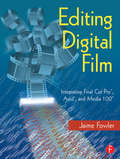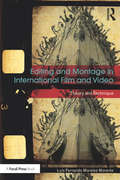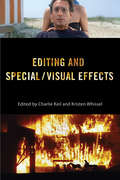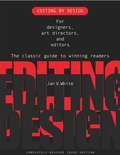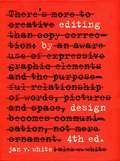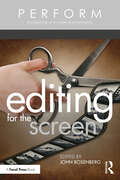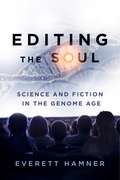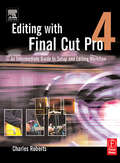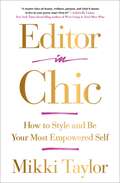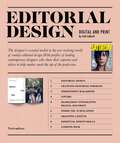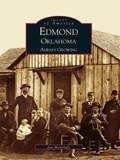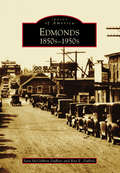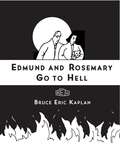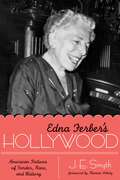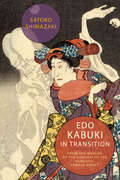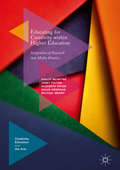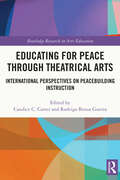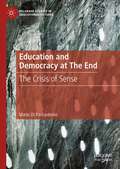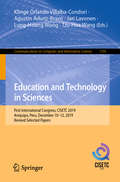- Table View
- List View
Editing Digital Film: Integrating Final Cut Pro, Avid, and Media 100
by Jaime FowlerAt long last, film and video editors are using the same systems to edit their projects, and Editing Digital Film is the guide to show them how to do it. This concise reference provides video and film editors familiar with the Avid, Media 100, and Final Cut Pro systems with crucial information they will need to edit on all three of these systems. In addition to showing film editors and directors working on DV projects how to edit for this new format, this text also clarifies the NLE process to those familiar with traditional film editing.With its focus on the essentials of integrating nonlinear editing with film, Editing Digital Film is an excellent resource for video editors wishing to edit films, and for film editors wishing to learn how films are integrated into nonlinear systems. With coverage the film cutting process, post production methods, telecine, matchback editing, HDTV, 24P, cutting DV, and all necessary tools to get the job done, this is the perfect guide for those interested in editing digital film.
Editing and Montage in International Film and Video: Theory and Technique
by Luís Fernando Morales MoranteEditing and Montage in International Film and Video presents a theoretical and practical approach to the art of editing. In this book, Luís Fernando Morales Morante explores the international history, technology, theory, practical techniques, psychology, and cognitive effects of editing across a range of media from around the world, featuring case studies from film, dramatic television, news media, music videos, commercials, and mobile-delivered formats, from the films of Sergei Eisenstein to Michael Jackson’s "Thriller" to coverage of the 2012 U.S. presidential elections. The book includes self-study exercises throughout to help readers put theory into practice.
Editing and Special/Visual Effects
by Kristen Whissel Dana Polan Ariel Rogers Scott Higgins Julie Turnock Tanine Allison Paul Monticone Dan North Professor Deron Overpeck Benjamin Wright Meraj Dhir Lisa Purse Professor Charlie KeilMost moviegoers think of editing and special effects as distinct components of the filmmaking process. We might even conceive of them as polar opposites, since effective film editing is often subtle and almost invisible, whereas special effects frequently call attention to themselves. Yet, film editors and visual effects artists have worked hand-in-hand from the dawn of cinema to the present day. Editing and Special/Visual Effects brings together a diverse range of film scholars who trace how the arts of editing and effects have evolved in tandem. Collectively, the contributors demonstrate how these two crafts have been integral to cinematic history, starting with the "trick films" of the early silent era, which astounded audiences by splicing in or editing out key frames, all the way up to cutting-edge effects technologies and concealed edits used to create the illusions. Throughout, readers learn about a variety of filmmaking techniques, from classic Hollywood's rear projection and matte shots to the fast cuts and wall-to-wall CGI of the contemporary blockbuster. In addition to providing a rich historical overview, Editing and Special/Visual Effects supplies multiple perspectives on these twinned crafts, introducing readers to the analog and digital tools used in each craft, showing the impact of changes in the film industry, and giving the reader a new appreciation for the processes of artistic collaboration they involve.
Editing by Design: For Designers, Art Directors, and Editors--the Classic Guide to Winning Readers
by Jan WhiteThis completely updated edition of an industry classic shows a new generation of editors and designers how to make their publications sing! Readers will find a treasury of practical tips for helping story and design reinforce each other and create powerful pages that are irresistible to readers. Brimming with hundreds of illustrations, Editing by Design presents proven solutions to such design issues as columns and grids, margins, spacing, captions, covers and color, type, page symmetry, and much more. A must-have resource for designers, writers, and art directors looking to give their work visual flair and a competitive edge!
Editing by Design: The Classic Guide to Word-and-Picture Communication for Art Directors, Editors, Designers, and Students
by Alex W. White Jan V. WhiteAn Industry Classic, Revised for the Modern Age This classic guide to winning readers for designers, art directors, and editors, has been completely updated to be applicable to both online and print publication design. Because it has truths about effective visual communication that transcend ever-changing technology, this book has been in continuous publication since 1974. Revised with the careful attention of widely respected author and professor of graphic design Alex W. White, Editing by Design, Fourth Edition, describes how both word people and design people have the same task: to reveal the true core of each message as plainly and compellingly as possible. It is a book vital to creators of today&’s online and print media. Readers will find ways to marry content and form, helping story and design to reinforce each other, and create pages that are irresistible. Brimming with three hundred illustrations, chapters cover a wealth of design and editing matters, including: How to think about &“editing&” and &“design&” as a word person and a design personTeamwork and collaboration for story clarityOriginality and inducement for the readerColumns and grids for organization and consistencyCovers and content listings as tools for deeper reader involvementHow to use type hierarchy to catch and lure readersRepresentational and non-representational imageryUsing color as a branding device Readers will learn how editor-designer collaboration can achieve maximum creative impact through the effective use of words, images, and space. Full of practical examples, this book is equally for designers looking for a deeper understanding of how to design better and for writers and editors wanting to communicate more vividly with the utmost impact, as well as for editorial directors and publishers seeking a competitive advantage.
Editing for the Screen (ISSN)
by John RosenbergCombining essays and interviews with editors from film and television, this collection explores the business side of film editing. Over 30 industry professionals dispel myths about the industry and provide practical advice on the business of film and TV editing.John Rosenberg has brought together contributions from Dody Dorn (Momento), Scott Conrad (Rocky), Kevin Tent (The Holdovers), Bruce Green (Cool Runnings), Nancy Forner (Buffy the Vampire Slayer), and Yu Jung Hou (American Born Chinese), among others, to provide diverse perspectives on editing a variety of formats from feature films to sitcoms, working with other departments, and breaking into the field as an assistant editor. Building on the craft of editing and looking at how aspiring editors can apply this to the industry, readers are taken through the process from getting started in the industry, to progressing through your career and getting ahead as an editor. Readers will also learn about entrepreneurial expectations in relation to marketing, strategies for contending with the emotional highs and lows of editing, and money management whilst pursuing a career in editing for film and television.Written for undergraduates and graduates studying film and TV editing, as well as aspiring editors, this book provides readers with a wealth of first-hand information that will help them create their own opportunities and pursue a career in film and television.
Editing the Soul: Science and Fiction in the Genome Age (AnthropoScene)
by Everett HamnerPersonal genome testing, gene editing for life-threatening diseases, synthetic life: once the stuff of science fiction, twentieth- and twenty-first-century advancements blur the lines between scientific narrative and scientific fact. This examination of bioengineering in popular and literary culture shows that the influence of science on science fiction is more reciprocal than we might expect.Looking closely at the work of Margaret Atwood, Richard Powers, and other authors, as well as at film, comics, and serial television such as Orphan Black, Everett Hamner shows how the genome age is transforming both the most commercial and the most sophisticated stories we tell about the core of human personhood. As sublime technologies garner public awareness beyond the genre fiction shelves, they inspire new literary categories like “slipstream” and shape new definitions of the human, the animal, the natural, and the artificial. In turn, what we learn of bioengineering via popular and literary culture prepares the way for its official adoption or restriction—and for additional representations. By imagining the connections between emergent gene testing and editing capacities and long-standing conversations about freedom and determinism, these stories help build a cultural zeitgeist with a sharper, more balanced vision of predisposed agency.A compelling exploration of the interrelationships among science, popular culture, and self, Editing the Soul sheds vital light on what the genome age means to us, and what’s to come.
Editing the Soul: Science and Fiction in the Genome Age (AnthropoScene: The SLSA Book Series #2)
by Everett HamnerPersonal genome testing, gene editing for life-threatening diseases, synthetic life: once the stuff of science fiction, twentieth- and twenty-first-century advancements blur the lines between scientific narrative and scientific fact. This examination of bioengineering in popular and literary culture shows that the influence of science on science fiction is more reciprocal than we might expect.Looking closely at the work of Margaret Atwood, Richard Powers, and other authors, as well as at film, comics, and serial television such as Orphan Black, Everett Hamner shows how the genome age is transforming both the most commercial and the most sophisticated stories we tell about the core of human personhood. As sublime technologies garner public awareness beyond the genre fiction shelves, they inspire new literary categories like “slipstream” and shape new definitions of the human, the animal, the natural, and the artificial. In turn, what we learn of bioengineering via popular and literary culture prepares the way for its official adoption or restriction—and for additional representations. By imagining the connections between emergent gene testing and editing capacities and long-standing conversations about freedom and determinism, these stories help build a cultural zeitgeist with a sharper, more balanced vision of predisposed agency.A compelling exploration of the interrelationships among science, popular culture, and self, Editing the Soul sheds vital light on what the genome age means to us, and what’s to come.
Editing with Final Cut Pro 4: An Intermediate Guide to Setup and Editing Workflow
by Charles RobertsWhether you've mastered the basics of Final Cut Pro and want to take your skills to the next level, or if you're a video editor new to Final Cut Pro and looking to put your own system together, this book is for you. Written by "chawla," a Final Cut Pro guru and veteran moderator on 2-Pop/Creative Cow, this book covers the interface basics and workflow but goes beyond to address intermediate techniques and timesaving tips for professional results. Roberts does not assume you have an IT staff on hand and therefore goes into crucial issues of set up, configuration, consumer advice on hardware purchasing, and troubleshooting. Equally valuable is coverage of working with formats such as standard definition, uncompressed, and FireWire DV.
Editor in Chic: How to Style and Be Your Most Empowered Self
by Mikki Taylor“First Lady of Beauty” and trusted lifestyle expert Mikki Taylor shares uplifting advice for women who want to cultivate their beauty both inside and out.Mikki is that girlfriend-in-the-know who you wish you could take everywhere you go—and now you can! Written in her signature, no-nonsense style, Editor in Chic delivers fabulous advice that will give you the confidence to be your best self every single day. From dress code to life code, Mikki shares hundreds of her favorite secrets, including the five products you need to perfect your complexion; the genius ingredient for living comfortably in heels; how to define a bankable wardrobe, be frugal, and look fabulous; unexpected drugstore buys that will give your everyday look a wake-up call; rules for mastering eye-catching makeup and the perfect red lip; ruminations on the challenges of hair loss and effective solutions; what really has the power to motivate or defeat you; why being “risk adverse” is to be “success adverse”; and much more. Whether you’re standing in front of the mirror debating what to wear to a last-minute event or trying to hold your peace in the middle of a confrontation, Editor in Chic gives you the necessary tools to stay affirmed, informed, and inspired in all aspects of your life.
Editorial Design
by Cath Caldwell Yolanda ZappaterraEditorial Design: Digital and Print is a comprehensive guide to the traditional and digital skills that a designer will need for a future career in visual journalism today – the design of magazines and newspapers for a wide variety of markets.Generously illustrated, including case studies, practical exercises and tips, examples of best practice and profiles of individual designers including Mark Porter, Scott Dadich and Janet Froelich, the book explains the fundamentals of editorial design and layout. Subjects covered include current and emerging digital formats, branding, how to create layouts, handling copy and images, design, and production skills and trends in editorial design. With insider advice and opinions from leading contemporary designers, the book is a practical reference and learning resource that will teach readers everything they need to know to reach the top of the profession.
Editorial Design Third Edition: Digital and Print
by Cath CaldwellEditorial Design presents designers with everything they need to know to create their own layouts, connecting editorial design history with current practice to enlighten and inspire the beginner as well as the more experienced designer.The third edition has been updated to reflect the latest developments in visual journalism, with over one hundred new images showcasing the very best in contemporary editorial design. New chapters have been added dedicated to independent magazines and the seamless integration of print with digital. This generously illustrated revised edition includes case studies, practical exercises and tips, along with updated profiles of leading designers in the field, who share their expertise and offer invaluable advice. The book design has been refreshed in a larger format for easy legibility of images, captions and text.
Editorial Design Third Edition: Digital and Print
by Cath CaldwellEditorial Design presents designers with everything they need to know to create their own layouts, connecting editorial design history with current practice to enlighten and inspire the beginner as well as the more experienced designer.The third edition has been updated to reflect the latest developments in visual journalism, with over one hundred new images showcasing the very best in contemporary editorial design. New chapters have been added dedicated to independent magazines and the seamless integration of print with digital. This generously illustrated revised edition includes case studies, practical exercises and tips, along with updated profiles of leading designers in the field, who share their expertise and offer invaluable advice. The book design has been refreshed in a larger format for easy legibility of images, captions and text.
Editorial Design: Digital And Print
by Cath CaldwellEditorial Design: Digital and Print is a comprehensive guide to the traditional and digital skills that a designer will need for a future career in visual journalism today – the design of magazines and newspapers for a wide variety of markets.Generously illustrated, including case studies, practical exercises and tips, examples of best practice and profiles of individual designers including Mark Porter, Scott Dadich and Janet Froelich, the book explains the fundamentals of editorial design and layout. Subjects covered include current and emerging digital formats, branding, how to create layouts, handling copy and images, design, and production skills and trends in editorial design. With insider advice and opinions from leading contemporary designers, the book is a practical reference and learning resource that will teach readers everything they need to know to reach the top of the profession.
Edmond Oklahoma: Always Growing
by Jan MattinglyFrom its humble beginnings in 1886 as a fuel and water pump house at Mile Marker 103 of the Santa Fe Railroad, through the eras of land run, statehood, oil boom, two world wars and beyond, the city of Edmond has always been growing. Today, a "beacon for the rest of Oklahoma," it boasts a vibrant community of over 70,000 residents. Edmond is home to the state's oldest continuously running newspaper, the Edmond Sun. The first church and schoolyard in Oklahoma Territory were located here, as well as the state's first institute for higher learning. Indeed, Central Normal School, now called the University of Central Oklahoma, has been at the heart of Edmond since the 1890s and is featured prominently throughout this book. Edmond is a railroad town, an oil town and a college town, depending on who you ask; but Edmondites both past and present simply know it as the "perfect town." Edmond, Oklahoma: Always Growing tells the story of this proud city through more than two hundred vintage photographs, many dating back to before the turn of the twentieth century.
Edmonds: 1850s–1950s
by Sara Mcgibbon Dubois Ray E. DuboisBefore Edmonds became a town, it was a forest of cedar trees and evergreens. The Puget Sound's various Indian tribes used the land for camping, the sea for fishing and clamming for meals, and the marshes for harvesting tules that they used to weave into items such as mats and baskets. Later, the area became known as Brackett's Landing, named after the man who began logging the forest and founded the town of Edmonds in 1890 and opened its first mills and schools. The Great Northern Railway arrived in 1891, bringing with it great prospects for commercial and residential prosperity. As the young town grew into a city, it thrived because of its location on the water. Private ferry boats called the "Mosquito Fleet" came from Seattle, and to this day, commercial and passenger ferries cross the Puget Sound to the Port of Edmonds, Kingston, and the rest of the Olympic peninsula.
Edmund and Rosemary Go to Hell
by Bruce Eric KaplanOne Sunday afternoon, an ordinary couple named Edmund and Rosemary decide to go for a walk in their Brooklyn neighborhood. Within moments, they are plunged into a wonderful, nerve-racking, hilarious, unique adventure that begins with a cell phone and ends in a jungle halfway around the world. In Edmund and Rosemary Go to Hell, famed New Yorker cartoonist Bruce Eric Kaplan uses his trademark incisive wit to explore what it is that prevents us from seeing all that we have. By turns wickedly funny and oddly touching, this provocative and ultimately hopeful picture book for adults will appeal to anyone who has ever been stuck in traffic or, more to the point, stuck inside themselves.
Edna Ferber's Hollywood: American Fictions of Gender, Race, and History (Texas Film and Media Studies Series)
by J. E. SmythEdna Ferber’s Hollywood reveals one of the most influential artistic relationships of the twentieth century—the four-decade partnership between historical novelist Edna Ferber and the Hollywood studios. Ferber was one of America’s most controversial popular historians, a writer whose uniquely feminist, multiracial view of the national past deliberately clashed with traditional narratives of white masculine power. Hollywood paid premium sums to adapt her novels, creating some of the most memorable films of the studio era—among them Show Boat, Cimarron, and Giant. Her historical fiction resonated with Hollywood’s interest in prestigious historical filmmaking aimed principally, but not exclusively, at female audiences. In Edna Ferber’s Hollywood, J. E. Smyth explores the research, writing, marketing, reception, and production histories of Hollywood’s Ferber franchise. Smyth tracks Ferber’s working relationships with Samuel Goldwyn, Leland Hayward, George Stevens, and James Dean; her landmark contract negotiations with Warner Bros.; and the controversies surrounding Giant’s critique of Jim-Crow Texas. But Edna Ferber’s Hollywood is also the study of the historical vision of an American outsider—a woman, a Jew, a novelist with few literary pretensions, an unashamed middlebrow who challenged the prescribed boundaries among gender, race, history, and fiction. In a masterful film and literary history, Smyth explores how Ferber’s work helped shape Hollywood’s attitude toward the American past.
Edna Ferber's Hollywood: American Fictions of Gender, Race, and History (Texas Film and Media Studies Series)
by J. E. SmythEdna Ferber’s Hollywood reveals one of the most influential artistic relationships of the twentieth century—the four-decade partnership between historical novelist Edna Ferber and the Hollywood studios. Ferber was one of America’s most controversial popular historians, a writer whose uniquely feminist, multiracial view of the national past deliberately clashed with traditional narratives of white masculine power. Hollywood paid premium sums to adapt her novels, creating some of the most memorable films of the studio era—among them Show Boat, Cimarron, and Giant. Her historical fiction resonated with Hollywood’s interest in prestigious historical filmmaking aimed principally, but not exclusively, at female audiences. In Edna Ferber’s Hollywood, J. E. Smyth explores the research, writing, marketing, reception, and production histories of Hollywood’s Ferber franchise. Smyth tracks Ferber’s working relationships with Samuel Goldwyn, Leland Hayward, George Stevens, and James Dean; her landmark contract negotiations with Warner Bros.; and the controversies surrounding Giant’s critique of Jim-Crow Texas. But Edna Ferber’s Hollywood is also the study of the historical vision of an American outsider—a woman, a Jew, a novelist with few literary pretensions, an unashamed middlebrow who challenged the prescribed boundaries among gender, race, history, and fiction. In a masterful film and literary history, Smyth explores how Ferber’s work helped shape Hollywood’s attitude toward the American past.
Edo Kabuki in Transition: From the Worlds of the Samurai to the Vengeful Female Ghost
by Satoko ShimazakiSatoko Shimazaki revisits three centuries of kabuki theater and its dynamic representations of medieval Japanese tales and tradition, boldly reframing Edo kabuki as a key player in the formation of an early modern urban identity. Challenging the common understanding of kabuki as a subversive entertainment and a threat to shogunal authority, Shimazaki argues that kabuki actually instilled a sense of shared history in Edo's inhabitants, regardless of their class. It did this, she shows, by constantly invoking "worlds," or sekai, largely derived from medieval military chronicles, and overlaying them onto the present. Shimazaki explores the process by which, as the early modern period drew to a close, nineteenth-century playwrights began dismantling the Edo tradition of "presenting the past" by abandoning their long-standing reliance on the sekai. She then reveals how, in the 1920s, a new generation of kabuki playwrights, critics, and scholars reinvented the form yet again, "textualizing" kabuki so that it could be pressed into service as a guarantor of national identity, in keeping with the role that the West assigned to theater. Shimazaki's vivid and engaging reinterpretation of kabuki history centers on the popular and widely celebrated ghost play Tokaido Yotsuya kaidan (Ghost Stories at Yotsuya, 1825) by Tsuruya Nanboku. Along the way, she sheds fresh light on the emergence and development of the ubiquitous trope of the vengeful female ghost, linking it to the need to explore new themes at a time when the old samurai worlds were rapidly losing their relevance.
Edo Kabuki in Transition: From the Worlds of the Samurai to the Vengeful Female Ghost
by Satoko ShimazakiSatoko Shimazaki revisits three centuries of kabuki theater, reframing it as a key player in the formation of an early modern urban identity in Edo Japan and exploring the process that resulted in its re-creation in Tokyo as a national theatrical tradition. Challenging the prevailing understanding of early modern kabuki as a subversive entertainment and a threat to shogunal authority, Shimazaki argues that kabuki instilled a sense of shared history in the inhabitants of Edo (present-day Tokyo) by invoking "worlds," or sekai, derived from earlier military tales, and overlaying them onto the present. She then analyzes the profound changes that took place in Edo kabuki toward the end of the early modern period, which witnessed the rise of a new type of character: the vengeful female ghost.Shimazaki's bold reinterpretation of the history of kabuki centers on the popular ghost play Tokaido Yotsuya kaidan (The Eastern Seaboard Highway Ghost Stories at Yotsuya, 1825) by Tsuruya Nanboku IV. Drawing not only on kabuki scripts but also on a wide range of other sources, from theatrical ephemera and popular fiction to medical and religious texts, she sheds light on the development of the ubiquitous trope of the vengeful female ghost and its illumination of new themes at a time when the samurai world was losing its relevance. She explores in detail the process by which nineteenth-century playwrights began dismantling the Edo tradition of "presenting the past" by abandoning their long-standing reliance on the sekai. She then reveals how, in the 1920s, a new generation of kabuki playwrights, critics, and scholars reinvented the form again, "textualizing" kabuki so that it could be pressed into service as a guarantor of national identity.
Educating for Creativity within Higher Education: Integration of Research into Media Practice (Creativity, Education and the Arts)
by Susan Kerrigan Phillip McIntyre Janet Fulton Elizabeth Paton Michael MeanyThis book provides innovative insights into how creativity can be taught within higher education. Preparing students for employment in a dynamic set of global creative industries requires those students to not only be resilient and entrepreneurial, but also to be locally focused while being globally aware. Therefore it is imperative that they acquire a thorough understanding of creative processes and practice as they try to keep pace with worldwide digital trends. As the creation of media messages is a fundamental aspect of global creative industries, and that numerous concerns practitioners face are based upon a certain understanding of creativity, the authors propose an exploration of what creativity is in terms of research, and then apply it pedagogically. Drawing on extensive empirical research, the authors pose the thought-provoking question of whether creativity can be taught. This volume will be of interest to both students and scholars of creativity and higher education as well as to creatively-based practitioners more widely.
Educating for Peace through Theatrical Arts: International Perspectives on Peacebuilding Instruction (Routledge Research in Arts Education)
by Candice C. Carter Rodrigo Benza GuerraThis volume illustrates how theatre arts can be used to enact peace education by showcasing the use of theatrical techniques including storytelling, testimonial and forum theatre, political humor, and arts-based pedagogy in diverse formal and non-formal educational contexts across age groups. The text presents and discusses how the use of applied theatre, especially in conflict-affected areas, can be used as an educational response to cultural and structural violence for transformation of relations, healing, and praxis as local and global peacebuilding. Crucially, it bridges performing arts and peace education, the latter of which is unfolding in schools and their communities worldwide. With contributors from countries including Northern Ireland, Denmark, Norway, the USA, Mexico, Japan, the Philippines, Pakistan, Burundi, Kenya, and South Africa, the authors identify theoretical and technical aspects of theatrical performance that support peace through transformation along with embodied and sensorial learning. This book will appeal to scholars and students with interests in teacher education, arts-based learning, peace studies, and applied theatre that consider practice with child, adolescent, and adult learners.
Education and Democracy at The End: The Crisis of Sense (Palgrave Studies in Educational Futures)
by Mario Di PaolantonioThis book grapples with what it means when education and democracy are at an end: when these two foundational aspects of our society seem to have reached a culminating point, no longer appearing to produce and make sense amid the crises of our time. Engaging topical political events and mobilizing a variety of cultural resources, Di Paolantonio shows that today the possibility of the future and the significance of an expansive transgenerational sensibility are radically in question as trends toward destruction, cruelty, and banality are steering world-defying calamities, and sparking “chronopathologies” of doom and despair among the planet’s occupants. Unfolding his argument through a series of accessible chapters that draw on contemporary philosophy, educational thinking, and cultural-artistic works, Di Paolantonio explores how the transgenerational sensibility retains a possibility we might tap for overcoming the impasses of our time.
Education and Technology in Sciences: First International Congress, CISETC 2019, Arequipa, Peru, December 10–12, 2019, Revised Selected Papers (Communications in Computer and Information Science #1191)
by Lung-Hsiang Wong Jari Lavonen Klinge Orlando Villalba-Condori Agustín Aduríz-Bravo Tzu-Hua WangThis book constitutes the refereed proceedings of the First International Congress on Education and Technology in Sciences, CISETC 2019, held in Arequipa, Peru, in December 2019. The 12 full papers presented in the volume were carefully reviewed and selected from 96 submissions. The papers are focused on the two main topics: pedagogical practice in the sciences, focused specificaly on science education; and complementary aspects of science teaching, which considers all the elements that can contribute to science education.
